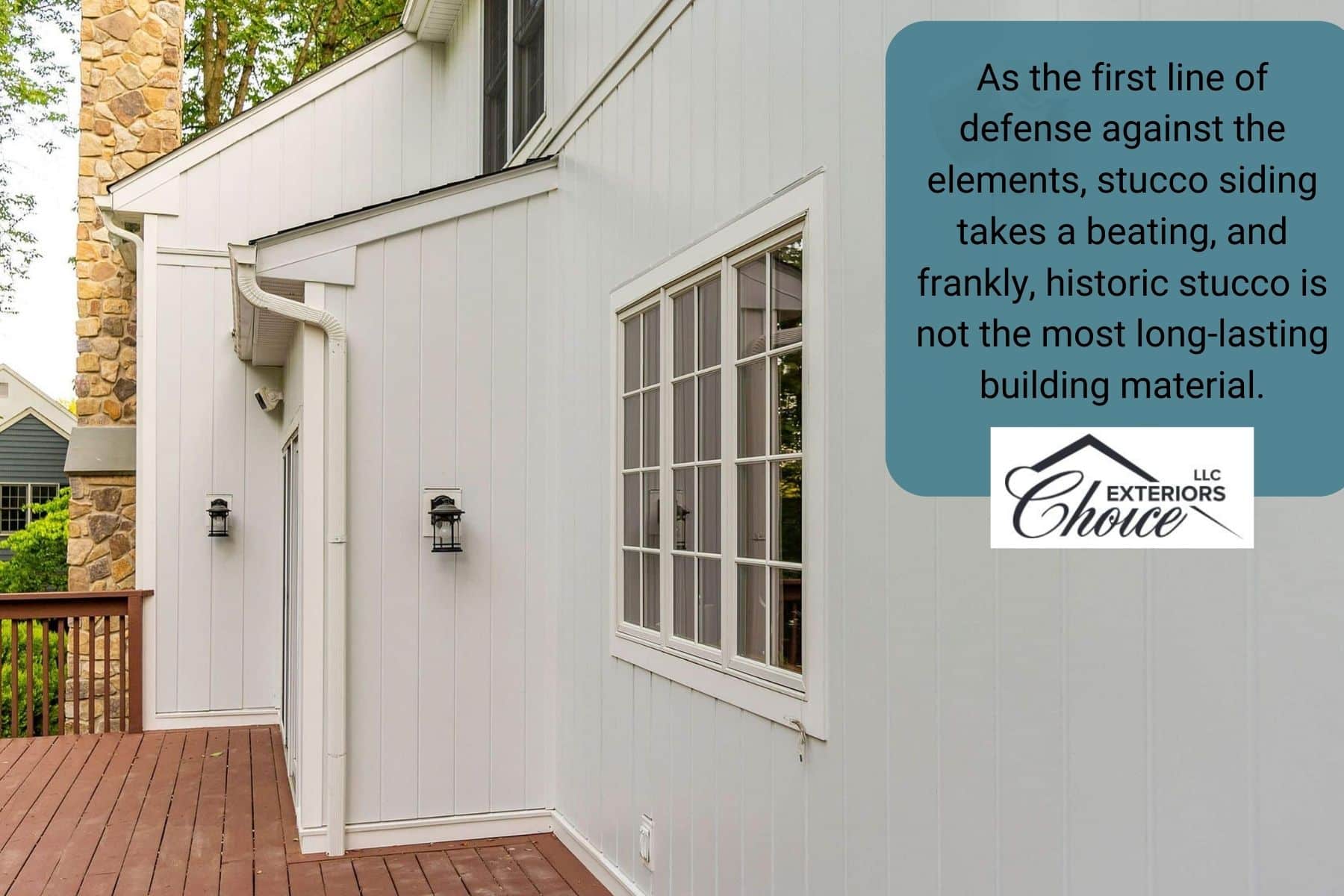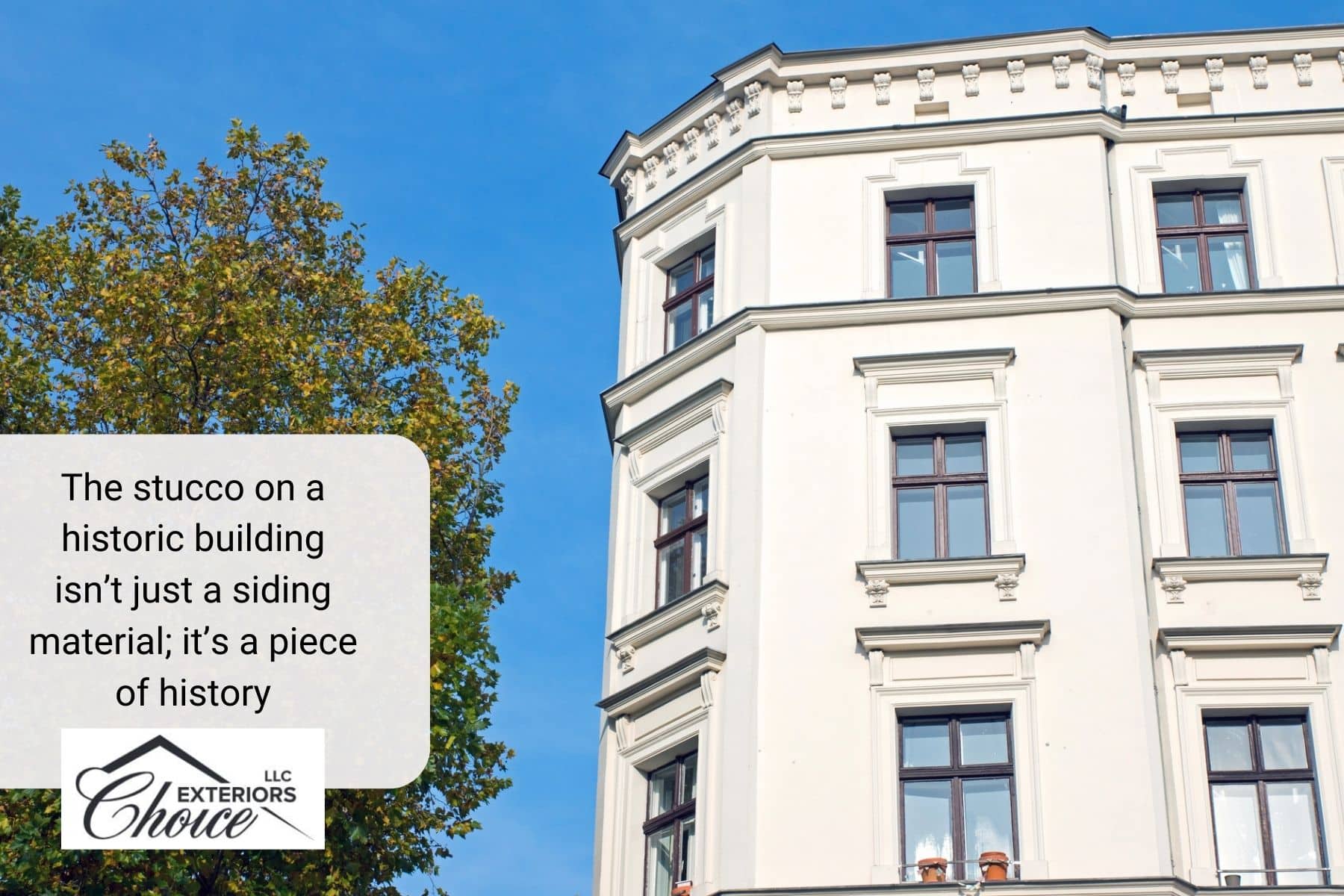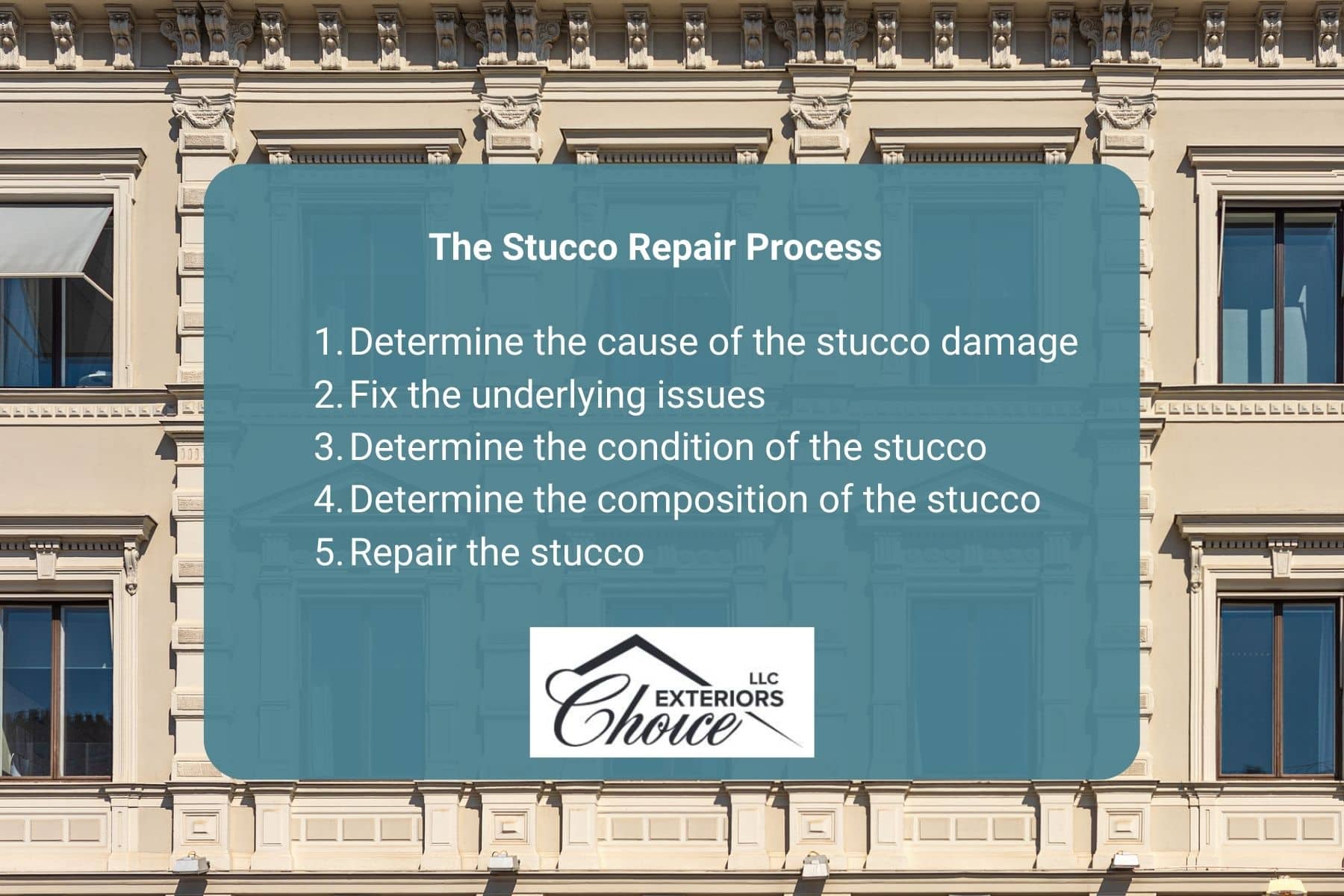Honoring History: Best Practices for Stucco Repair on Historic Structures
Isn’t it amazing to walk through a historic building, marvel at the beautiful craftsmanship, and get a glimpse of how people from long ago might have lived?
Historic buildings are more than just unique architecture; they link us to the past, help us understand the culture of our ancestors and bear witness to the triumphs, challenges, and changes of society.
However, maintaining these historic buildings can be challenging. Building materials crumble over time, and the longer they go unrepaired, the more moisture creeps in the cracks. Then, nature begins to break down and reclaim the buildings.
One popular building material from the past that deteriorates over time is stucco. Here at Choice Exteriors, our specialization in stucco remediation has led us to be particularly concerned with repairing historical stucco.
This blog post delves into stucco repair for historic buildings, exploring the considerations and best practices involved in preserving these architectural treasures for future generations.
Let’s get started!
What Is Historic Stucco?
Stucco is a building material made from an aggregate (typically sand), a binding agent, and water, spread on the outside of buildings as a decorative and protective coating. The same general material is called “plaster” if it’s used as a coating inside a building, and “mortar” if it’s used to hold bricks or stones together.
People have used stucco as a building material since antiquity. But the stucco commonly used today may be composed of different materials than the stucco on historic buildings. That’s because, historically, lime was the primary binding agent used in stucco. However, in the late 19th century, Portland cement began to replace lime as the primary binding agent used in stucco.
Historic stucco also used mixing and applying techniques that may differ from modern techniques. Conservationists must be careful when repairing historic stucco to stay as true to the historic stucco techniques as possible.
How Stucco Damage Impacts Historic Buildings
No matter what buildings are made of, they are all susceptible to the same enemies: time, wind, and especially rain. Once water is able to penetrate and break down a structure, it’s surprising how quickly nature takes over.
As the first line of defense against the elements, stucco siding takes a beating, and frankly, historic stucco is not the most long-lasting building material.

Over time, it forms cracks or breaks off in chunks.
The problem with cracks and holes in stucco is that water can seep in and start to compromise the integrity of the structure.
Stucco damage may be more or less alarming depending on the composition of the building. For example, a brick or stone building may be able to withstand missing stucco better than a wooden building can. In fact, you may prefer the look of a brick or stone building with some of the stucco gone.
Just remember that the protective layer of stucco was there for a reason. A complete building restoration will require stucco repair. If you like the look of exposed brick under chipped stucco, you may be able to protect it with a clear sealant instead of repairing the stucco. But don’t take our word for it—call a local historical preservation expert for the best advice on preserving the historic buildings in your area!
Should Historic Stucco be Remediated or Repaired?
Stucco repair involves fixing chipped or cracked stucco but mostly leaves existing stucco intact. Stucco remediation is a much more thorough process that involves the complete removal of existing stucco, fixing underlying issues, and applying brand-new stucco or an alternate siding.
Stucco remediation is recommended for homes that have underlying damage or improperly-applied stucco. It’s a great way to fix all the stucco issues at once and get a fresh start. (For more info, read our blog post: The Homeowners’ Guide to Stucco Remediation.)
However, the rules are a little different when it comes to historical buildings.
You see, the stucco on a historic building isn’t just a siding material; it’s a piece of history.

The texture and composition of the stucco transport us to another era. It’s mind-blowing to look at a building and realize that these are the original materials used over 100 years ago.
Because of this, historic preservation experts recommend keeping as much of the original stucco intact as possible. This means that historic stucco should be repaired rather than remediated except for the most dire circumstances.
Understanding the Stucco Repair Process
Before repairing historic stucco, consult a historic preservation expert to determine how to proceed. Whether you do the repairs yourself or call in an expert, these are the basic steps to restoring historic stucco.
1. Determine the cause of the stucco damage
Most stucco damage is caused by moisture. There may be leaks in the roof, around windows and doors, or along the chimney. Maybe the gutters or downspouts leak or inadequate ventilation has been causing moisture to condense on the walls.
Damage can also be caused by a settling foundation or intrusive plants such as ivy. No matter what causes the damage, it’s vital to figure out the cause of the damage before moving forward with the repair.
2. Fix the underlying issues
Complete all necessary structural repairs before fixing the stucco. Most importantly, fix whatever caused the moisture infiltration. For example, you’ll likely need to install adequate flashing.
3. Determine the condition of the stucco
Test your stucco to figure out what can be saved and what can’t. Sometimes, it will be evident because large chunks will be missing. But some areas will be less noticeable, requiring an expert assessment.
4. Determine the composition of the stucco
It’s impossible to replicate historic stucco with 100% accuracy because materials have changed over time. For example, historic stucco was made with river sand, whereas sand today is manufactured. There’s also no way to know the historic mixing and applying methods.
However, tests can be conducted on stucco to find its basic makeup, allowing the restorer to make a stucco mixture as close to the original as possible. The most important thing is to use a lime-based stucco instead of a Portland cement-based stucco on historic buildings that originally had a lime-based stucco.
5. Repair the stucco
Stucco repair on historic buildings involves removing damaged stucco and applying new stucco. Take care to match the new stucco to the old as well as possible, and unless you have extensive experience applying stucco, you should hire an expert for this job.

How to Maintain Stucco After Repair
After repairing your stucco, it’s essential to maintain it to prevent stucco issues in the future!
The most important thing to remember is that water is the enemy of stucco. Keep your flashing and drainage systems in good repair, and regularly inspect your building for damage or potential issues.
You can also apply a sealant to your stucco to help maintain it. But make sure to consult with a preservation expert first!
Overall, keep your stucco clean, keep the building in good repair, and keep plants from growing on or against your building, and your stucco should last a long time.
Conclusion
Here at Choice Exteriors, we care about preserving buildings. Our goal is to keep your home in excellent repair so it’ll last for generations.
If your stucco siding is deteriorating, water is seeping inside and damaging your home, and you don’t want that! That’s why we offer stucco remediation that will fix the problem by removing aging, damaged stucco and replacing it with a beautiful, stylish, and weather-resistant home exterior!
We also sell and install:
We’re passionate about quality work, and we hope that with our help, your home will last for generations until it’s a well-preserved historic home!
If you live in Southeastern Pennsylvania, New Jersey, or Delaware, give us a call today to chat about your project, or contact us here to schedule an estimate.
We look forward to working with you.





It appears to be a helpful resource for those involved in the restoration and maintenance of historic buildings with stucco exteriors.